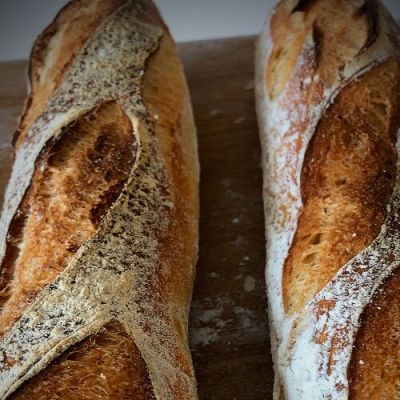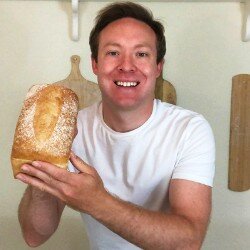
What Knife To Use For Scoring Bread?

Before bread goes into the oven it is scored or cut with a sharp blade. Scoring allows the excess gas that builds up inside the baking bread to escape. The release of the gas prevents the crust from rupturing and looking unappealing. A baker’s lame, also known as a “grignette” is used to make the cuts. These specialist bread knives are made from a thin scalpel razor blade. It is sharp, lightweight and less likely to drag on the surface of the dough. A baker’s lame is an essential tool for any bread baker wanting to make professional-looking bread. Ergonomics is important! In this article, we are going to cover the four types of bread lame you can buy, other alternatives and what is the best knife for scoring bread.
What is the best lame for baking bread?
There are four category types of lame available to bread bakers. Here are my recommended choices for each:
- Bordelaise Grignette From Mure and Peyrot
- UFO Round Bakers Lame
- Curved Lame
- Wooden Handle Lame
Best bread lame for beginners
Bordelaise Grignette From Mure and Peyrot

Cheap, lightweight and straightforward. Mure and Peyrot are the industry standard for professional baker lame’s. Despite this one being my beginner’s choice, I find the lightweight design of the Bordelaise Grignette the best. It’s the easiest to hold, its blue colour makes it hard to lose (yes, that can be a problem!), and I can make any cuts with ease.
Best bread lame for intricate designs
UFO Round Bakers Lame

These round cutters are very popular for creating pretty bread designs with accuracy. I prefer the pen-shaped stick design as they are what I’m used to, but I can see why others love this design. Many home bakers are using this style at the moment to score bread art masterpieces. You hold the lame closer to the dough, which makes it easier to perfect each stroke. More heart surgery, less like an artist.
Best bread lame for baguettes
Curved Lame

If you want the classic crescent cuts on baguettes, you’ll need to use a curved lame like this one by Mure & Peyrot. A lame in this style is used to create the classic almond-shaped slashes on baguettes and other French loaves of bread. Beginners find this blade style tricky to master, and whilst the curved scores are excellent for French-style loaves, you’ll want a straight-edge version as well for other designs.
The most ergonomic bread lame
Wooden Handle Lame

This chunky handled lame reminds me of driving an SUV. It’s bigger and meaner than everyone else, but is it any better? Well, a wooden-handled lame that’s as well-made as this one appears to be an upgrade to the Bordelaise Grignette. This lame looks incredible, and there’s something about the chunky handle that empowers me to make quality bread! It’s very durable. I imagine it will last a lifetime. On the downside, it is heavier than the others on this list, which, whilst feeling high-quality, would tire my arms if I used it in an industrial environment.
How to use a lame to score bread
If you’ve never used a lame before, it’s like holding a pen. To learn several scoring designs visit my how to score bread page.
How to change a blade on a bread lame
Where can I get blades from a baker’s lame?
It is hard to find stores that sell baker’s lames or replacement blades. A few catering stores and cooking shops stock them, but it’s easier and (usually) cheaper to order replacement blades online. Here’s a link to the blades I use.

What’s the difference between a Lame and a Grignette?
A Lame (pronounced “LAHM”) means “blade” in French. A Grignette is technically the handle. Lame and Grignette are often used interchangeably for “a device to cut bread dough!”
I can’t get a baker’s lame, what can I use as a lame alternative?
If you can’t get a baker’s lame, a serrated knife will work for simple cuts. A thin serrated knife is preferred, but a standard bread knife is usually fine for a straight cut. I do this often when I can’t find my lame!
How to use a knife to score bread?
Can I make my own lame?
It is possible to make your own curved device for slashing the bread. It isn’t something I’m going to recommend, but if you are interested, here’s a YouTube video (as it contains knives, it’s restricted).
Ending thoughts on the best bread lame
We’ve seen 4 bread lames that I recommend, depending on what your use is for. Once you’ve found your lame choice, look at the article how to score bread for tips on how to use it and basic scoring patterns. I’m interested… If you already have a bread lame, which one do you have? What do you think about it? Let me know in the comments below.
Frequently asked questions about the best bread lame
If you’ve enjoyed this article and wish to treat me to a coffee, you can by following the link below – Thanks x

Hi, I’m Gareth Busby, a baking coach, senior baker and bread-baking fanatic! My aim is to use science, techniques and 15 years of baking experience to make you a better baker.
Table of Contents
- What is the best lame for baking bread?
- Best bread lame for beginners
- Best bread lame for intricate designs
- Best bread lame for baguettes
- The most ergonomic bread lame
- How to use a lame to score bread
- How to change a blade on a bread lame
- What’s the difference between a Lame and a Grignette?
- I can’t get a baker’s lame, what can I use as a lame alternative?
- Ending thoughts on the best bread lame
- Frequently asked questions about the best bread lame
Related Recipes
Related Articles
Latest Articles
Baking Categories
Disclaimer
Address
53 Greystone Avenue
Worthing
West Sussex
BN13 1LR
UK








Leave a Reply